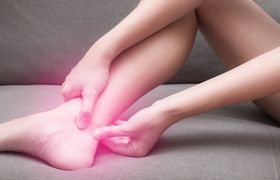Upstep Answers
Our team answers your questions about the causes and treatment of various podiatric conditions, including plantar fasciitis, flat feet, foot pain, and the use of custom orthotics.
Recent Answers
What Are the Benefits of Eccentric Heel Raises?
Eccentric heel raises are a low-impact exercise that anyone can perform with only a box or stair to stand on. How to do eccentric heel raises: Place the balls of your feet on the raised surface.Lift y
Asked 4 years ago
What is a Goga Mat Insole?
Goga Mat insoles are often confused with memory foam insoles, but there are definitely some prominent differences between the two. » How do you choose which insoles to buy? Peruse Upstep's wide range
Asked 4 years ago
Should I Refurbish Custom Orthotics or Buy New Ones?
Orthotics don't last forever, and at some point, they will be too worn down to give you any more use. Continuing to wear them could bring about more problems than benefits, and so you'll have to decid
Asked 4 years ago
Can You Work Out in Orthotics?
Using orthotics during workouts can be useful if you want to keep your feet in a good condition. A well-designed pair of orthotics can make things easier for you while lifting weights, but there are a
Asked 4 years ago
Why Do My Custom Orthotics Hurt While Breaking In?
It is natural for custom orthotics to be uncomfortable in the first few weeks when your feet are still getting used to them. This varies from person to person and may take anywhere from 5 days to a mo
Asked 4 years ago
Related Articles

Can Orthotic Insoles Help Treat Achilles Tendonitis?
Dr. Pooja Gajare
March 24, 2023

How to Reduce Pain from Past Injuries to Improve Quality of Life
Upstep Staff
December 20, 2024

Can People With Flat Feet Be Top Athletes?
Babafemi Adebajo
December 9, 2024

Do You Have Hypothyroidism From Your Burning Feet?
Janik Sundstrom
December 19, 2024

Acute Heel Pain in the Morning: Why It Happens & How to Get Relief
Janik Sundstrom
July 16, 2025
Recent Posts
Babafemi Adebajo
7 Best Insoles to Alleviate General Calf Pain
Babafemi Adebajo
Persistent Shin Splints: Why Won’t They Go Away?
Babafemi Adebajo
Vitamins for Shin Splints: Choose the Right Supplements
Babafemi Adebajo
7 Best Orthotics to Aid With Your Lower Back Pain
Babafemi Adebajo
Best Insoles for Plantar Fibroma
Babafemi Adebajo



